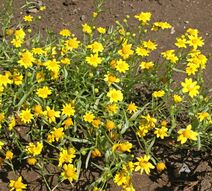Lasthenia glabrata
| Lasthenia glabrata | |
 | |
| Light: | |
| Moisture: | |
| Soil pH: | 5.6-8.4 |
| Height: | 1' |
| Blooms: | Late Spring-Mid Summer |
| Native to: | |
| Edible Rating: | |
| Tea: | Yes |
Lasthenia glabrata (common names: yellowray goldfields and goldfields)
Propagation: Seed - sow early to mid spring in situ[1][2].
Seed can also be sown in situ in early to mid autumn but this sowing will normally require some protection from winter cold[1][2].
Cultivation: An easily grown plant, succeeding in any well-drained soil, including nutritionally poor ones[2]. It prefers a sunny position[2]. Another report says that it requires a moderately good garden soil and a warm sheltered position[1].
An annual plant, germinating in the autumn and growing through the winter in California[3].
A second flowering can be obtained from plants if they are trimmed back after flowering and before setting seed[2].
Range: South-western N. America - California.
Habitat: Heavy soils, vernal pools, low alkaline fields, hillsides etc, especially in grassland and alkaline marshes, to 1300 metres[3].
Edibility: Seed - raw or cooked. The seed can be parched and eaten dry or made into a powder and eaten dry or cooked like a porridge[4][5][6].
Pollinators: Insects
Soil: Can grow in light, medium, and heavy soils.
Drainage: Prefers well drained soil.
Flower Type: Hermaphrodite
Links
References
- ↑ 1.0 1.1 1.2 Chittendon, Fred. RHS Dictionary of Plants. Oxford University Press, 1951.
- ↑ 2.0 2.1 2.2 2.3 2.4 Huxley, Anthony. The New Royal Horticultural Society Dictionary of Gardening. MacMillan Press, 1992.
- ↑ 3.0 3.1 Munz, David. A California Flora. University of California Press, 1959.
- ↑ Tanaka, Tyōzaburō. Tanaka's Cyclopaedia of Edible Plants of the World. Keigaku Publishing, 1976.
- ↑ Yanovsky, Elias. Food Plants of the North American Indians Publication 237. US Department of Agriculture.
- ↑ Moerman, Daniel. Native American Ethnobotany. Timber Press, 1998.